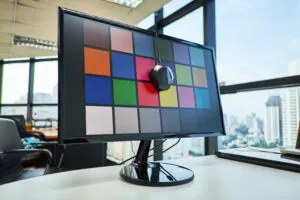
Visual comparison between different TV resolution sizes. (Image Credit: Kaspars Grinvalds/Shutterstock.com)
In the competitive landscape of consumer electronics, display quality is paramount. Manufacturers face the dual challenge of ensuring high performance while managing production complexities. This article delves into the measurement challenges associated with these display components, highlighting how innovative testing solutions enhance product quality and consumer satisfaction.
XHEAD Ensuring display quality
Liquid crystal displays (LCDs) and light-emitting diode (LED) displays are now vital components in modern electronics, including smartphones, televisions, and even compact wearables. Many small devices today use active matrix organic light-emitting diode (AMOLED) configurations due to their efficiency and vibrant visuals. Various display technologies serve different applications and price ranges. To ensure quality and reliability, thorough testing is essential while post-assembly testing confirms functionality and visual accuracy.
XHEAD OLED brightness testing
The inherent luminance and color inconsistencies across pixels, even within the same production batch, means that OLED brightness testing using specialised equipment like luminometers is vital. Manufacturing variations like material deposition or microLED transfer issues can cause visual defects like line mura—visible horizontal or vertical lines.
Each OLED pixel contains red, green, and blue (RGB) subpixels that emit light independently, but differences in subpixel brightness lead to uneven luminance and colour non-uniformity, affecting image quality. As OLED displays become standard in high-end mobile and tablet devices for their superior contrast and color, maintaining display consistency has become increasingly challenging.

LED Monitor is calibrated by showing pan tone to display true colors on screen. (Image Credit: Capital Letter/Shutterstock.com)
Manufacturers perform precise brightness and colour calibration for each unit to ensure a uniform visual experience. Rigorous testing using electrical and optical measurements to generate current-voltage-luminance (IVL) curves is essential for optimising OLED performance, power efficiency, and luminance, ensuring high display quality.
Automated visual inspection (AVI) / automated optical inspection (AOI) using imaging colourimeters enhances manufacturing by improving display quality control, ensuring consistency across production lines, and enabling both full-display and pixel-level defect detection. It supports calibration to correct dim subpixels, which is especially beneficial as display sizes increase and yields drop. This leads to better luminance uniformity, accurate colour reproduction, increased efficiency, and improved user experience -ultimately protecting brand perception.
Display pixel uniformity correction relies on two key components: in-display electronics capable of adjusting individual subpixel brightness and a high-precision measurement system to determine correction factors based on each subpixel’s brightness and colour. This approach, commonly used in LED screens, has been adapted to emissive displays like OLED and microLED through a correction technique called demura. After assembly, test images targeting specific color outputs are shown on the display, allowing calibration to be computed for each subpixel.
Due to the extreme pixel density of modern OLED and microLED displays, accurately measuring every subpixel becomes challenging. For full high definition (HD) and lower-resolution displays, a 29Mpixel imaging system is typically sufficient. For higher-resolution or larger displays, even advanced imaging systems may struggle to capture all pixels in a single shot. To address this, demura employs a method called spaced pixel test pattern analysis, enabling full measurement coverage using a single photometric or colourimetric imaging system.
XHEAD Colour calibration
Color accuracy is vital for OLED and quantum dot light emitting diode (QLED) display panels, ensuring true-to-life image reproduction and enhancing user experience in professional and artistic contexts. These display technologies face challenges in maintaining consistent colour output due to their differing light-emission methods. Key challenges include achieving display uniformity, where manufacturing variations cause inconsistent colour across the screen, and pixel aging, where prolonged use degrades individual pixels, affecting colour fidelity.
Accurate colour calibration is essential to overcome these limitations and deliver high-quality visuals. Ultimately, precise colour reproduction allows users to fully appreciate the creator’s intent and supports industry-standard visual performance. Calibration of OLED and QLED panels involves adjusting settings like contrast, gamma curves, brightness, and colour temperature to ensure accurate image reproduction. This process enhances visual quality beyond traditional LCDs.
Hardware calibration uses tools like colorimeters/spectrophotometers to align colours with industry standards. Additionally, colour management software enables users to create custom profiles, ensuring consistent colour across devices. It offers advanced features such as white point adjustment, gamma correction, and colour space conversion for precise calibration.
As part of research published in Electronic Imaging colour calibration models were comprehensively evaluated to determine their effectiveness for OLED displays. The researchers used a large dataset of colour measurements from a high-refresh-rate, multi-primary OLED display to develop inverse display models that map colourimetric values to RGB inputs. They found that unlike traditional LCDs, multi-primary OLED displays exhibited non-linear and non-additive colour responses.
Several regression techniques were tested, including polynomial regression, look-up tables (LUTs), and multi-layer perceptrons. Among these, the LUT method was the best-performing model for most of the conditions, while fourth-degree polynomial models provided a strong balance between colour fidelity and computational efficiency based on the calculations of the per-luminance mean colour difference errors and mean and median errors for the whole test set.
The study noted that optimal calibration methods may vary across OLED displays due to differences in manufacturers’ technologies. The influence of average picture level (APL) was not considered in this analysis.
XHEAD Touchscreen responsiveness
Touchscreens detect input through touch/stylus and provide responses like haptic, visual, or audio feedback, making them both input and output devices. To ensure functionality and meet user expectations, manufacturers conduct various tests at both the device and component levels during development and quality assurance. To effectively test a touchscreen, various functional tests are required to detect potential defects and ensure accurate performance. One key test is the touch gesture test, which evaluates the accuracy of single and multi-touch inputs across the entire touch panel surface to verify proper interaction handling.
Tap tests assess the device under test (DUT) for tap accuracy and repeatability by measuring coordinate consistency when the same point is pressed repeatedly. Swipe tests evaluate the accuracy of linear swiping gestures, reporting values like offset and missed swipes. Jitter tests measure the DUT’s stability when a single point is pressed and held, reporting the maximum stationary jitter from the initially reported coordinate. Reporting rate tests analyse the frequency of coordinate data reported by the DUT under stationary and moving conditions.
Additional performance-level tests include first contact latency tests, which measure the response time from idle and active states, and hover tests, which assess jitter, missing swipes, and the maximum effective hover distance above the touch surface. For multi-finger interactions, the separation test determines the DUT’s ability to distinguish between individual fingers based on spacing. It reports maximum allowable separation distances in both vertical and diagonal directions.
Beyond gesture-based testing, component responsiveness checks ensure interactive elements react appropriately under specific actuation forces, confirming overall system reliability. Calibration checks verify that the touchscreen accurately detects inputs, which is crucial for maintaining precision during all touch interactions.
Touchscreen testing is often performed through separate test procedures, requiring manual pass/fail assessments or custom gesture simulation tools. This fragmented approach consumes significant time and resources, impacting testing accuracy and production efficiency. Additionally, frequent changes in touch screen designs demand ongoing updates to testing procedures and equipment, further increasing production costs. In high-volume manufacturing, where quality, speed, and cost control are critical, efficient touch screen testing solutions are essential.8,9
Comprehensive automated functional touch screen testers, like those developed by SPEA, address these challenges by integrating all key touchscreen test types into a single system. These testers feature fully integrated vision units and high-precision, high-speed robotic actuators mounted on moving flying heads, and capable of simulating human gestures and real-world interactions. This setup enhances measurement accuracy, reduces testing time, and ensures full traceability and repeatability.
XHEAD Display driver ICs
High-resolution LCD and OLED displays are increasingly integrated, with modern display driver integrated circuits (DDIs) incorporating several logic and analogue circuits to manage advanced operations, including touch-sensor functions. Simultaneously, growing use in mobile devices drives demand for smaller, more capable DDIs, posing significant testing challenges. To address this, testers like Advantest‘s T6391 system offer high-throughput, cost-efficient testing solutions tailored for high-resolution DDIs, supporting faster interfaces and a greater number of pins to meet evolving industry requirements.
The T6391 is a flexible pin-card design suitable for both engineering and mass production. It supports testing of advanced features like touch and display driver integration (TDDI) and embedded power management integrated circuit (PMIC) functions within DDIs, addressing current and future market needs.
The T6391 enables large-volume, parallel testing of high-resolution DDIs with up to 3,584 pins for full HD, quad high definition (QHD), and 4K displays, using a high-speed bus and 1,024 input/output channels for enhanced throughput. It handles input/output pin frequencies up to 1.6Gbps to test DDIs using the mobile industry processor interface. High-speed interface testing even over 6.5Gbps, which is required DDIs for ultra-HD televisions, is possible when equipped with an additional UHSIF measurement module.
XHEAD Complex challenges
The measurement challenges in display components highlight the complexity of ensuring high-quality performance in modern consumer electronics. Advanced testing technologies and automated systems are crucial to address issues like pixel uniformity, colour accuracy, and touch input precision. Innovations in testing solutions not only improve product quality but also contribute to cost efficiency and faster production cycles. As display technologies continue to evolve, these testing methods will be vital in meeting consumer expectations and maintaining industry standards. Ultimately, rigorous testing ensures superior display quality and enhances user experience.
About the Author
Samudrapom Dam is an electronics engineer and scientific writer for Hygia Medcomms Solutions
Related
